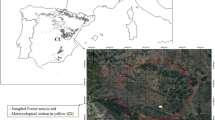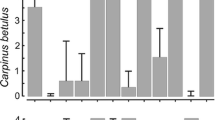Abstract
Mast-seeding conifers such as Picea glauca exhibit synchronous production of large seed crops over wide areas, suggesting climate factors as possible triggers for episodic high seed production. Rapidly changing climatic conditions may thus alter the tempo and spatial pattern of masting of dominant species with potentially far-reaching ecological consequences. Understanding the future reproductive dynamics of ecosystems including boreal forests, which may be dominated by mast-seeding species, requires identifying the specific cues that drive variation in reproductive output across landscape gradients and among years. Here we used annual data collected at three sites spanning an elevation gradient in interior Alaska, USA between 1986 and 2011 to produce the first quantitative models for climate controls over both seedfall and seed viability in P. glauca, a dominant boreal conifer. We identified positive associations between seedfall and increased summer precipitation and decreased summer warmth in all years except for the year prior to seedfall. Seed viability showed a contrasting response, with positive correlations to summer warmth in all years analyzed except for one, and an especially positive response to warm and wet conditions in the seedfall year. Finally, we found substantial reductions in reproductive potential of P. glauca at high elevation due to significantly reduced seed viability there. Our results indicate that major variation in the reproductive potential of this species may occur in different landscape positions in response to warming, with decreasing reproductive success in areas prone to drought stress contrasted with increasing success in higher elevation areas currently limited by cool summer temperatures.




Similar content being viewed by others
References
Allen RB, Norman WH, Richardson SJ, Platt KH (2012) Synchronicity, periodicity, and bimodality in inter-annual tree seed production along an elevation gradient. Oikos 121:367–376
Barber VA, Juday GP, Finney BP (2000) Reduced growth of Alaska white spruce in the twentieth century from temperature-induced drought stress. Nature 405:668–672
Burnham KP, Anderson DR (2002) Model selection and multimodel inference: a practical information-theoretic approach, 2nd edn. Springer, New York
Bykova O, Chuine I, Morin X, Higgins SI (2012) Temperature dependence of the reproduction niche and its relevance for plant species distributions. J Biogeogr 39(12):2191–2200
Crone EE, McIntire EJB, Brodie JF (2011) What defines mast seeding? Spatio-temporal patterns of cone production by whitebark pine. J Ecol 99(2):438–444
Danby RK, Hik DS (2007) Variability, contingency and rapid change in recent subarctic alpine tree line dynamics. J Ecol 95:352–363
Gaertner SM, Lieffers VJ, Macdonald SE (2011) Ecology and management of natural regeneration of white spruce in the boreal forest. Environ Rev 19:461–478
Hoch G, Siegwolf RTW, Keel SG, Korner C, Han QM (2013) Fruit production in three masting tree species does not rely on stored carbon reserves. Oecologia 171(3):653–662
Ichie T, Igarashi S, Yoshida S, Kenzo T, Masaki T, Tayasu I (2013) Are stored carbohydrates necessary for seed production in temperate deciduous trees? J Ecol 101(2):525–531
Janzen DH (1976) Why bamboos wait so long to flower. Annu Rev Ecol Syst 7:347–391
Juday GP, Alix C (2012) Consistent negative temperature sensitivity and positive influence of precipitation on growth of floodplain Picea glauca in interior Alaska. Can J For Res 42:561–573
Juday GP, Barber V, Rupp S, Zasada JC, Wilmking M (2003) A 200-year perspective of climate variability and the response of white spruce in interior Alaska. In: Greenland D, Goodin DG, Smith RC (eds) Climate variability and ecosystem response at long-term ecological research sites. Oxford University Press, Oxford, pp 226–250
Juday GP, Barber VA, Duffy PA, Linderholm H, Rupp TS, Sparrow S, Vaganov EA, Yarie J (2005) Forests, land management, and agriculture. In: ACIA (eds) Arctic climate impact assessment. Cambridge University Press, New York
Kelly D (1994) The evolutionary ecology of mast seeding. Trends Ecol Evol 9(12):465–470
Kemp GA, Keith LB (1970) Dynamics and regulation of red squirrel (Tamiasciurus hudsonicus) populations. Ecology 51(5):763–779
Koenig WD, Knops JMH (1998) Scale of mast-seeding and tree-ring growth. Nature 396:225–226
Koenig WD, Knops JMH (2000) Patterns of annual seed production by northern hemisphere trees: a global perspective. Am Nat 155:59–69
Krebs CJ, LaMontagne JM, Kenney AJ, Boutin S (2012) Climatic determinants of white spruce cone crops in the boreal forest of southwestern Yukon. Botany 90:113–119
LaMontagne JM, Boutin S (2007) Local-scale synchrony and variability in mast seed production patterns of Picea glauca. J Ecol 95:991–1000
Mencuccini M, Piussi P, Zanzi Sulli A (1995) Thirty years of seed production in a subalpine Norway spruce forest: patterns of temporal and spatial variation. For Ecol Manage 76:109–125
Mooney KA, Linhart YB, Snyder MA (2011) Masting in ponderosa pine: comparisons of pollen and seed over space and time. Oecologia 165:651–661
Morin X, Viner D, Chuine I (2008) Tree species range shifts at a continental scale: new predictive insights from a process-based model. J Ecol 96(4):784–794
Nienstaedt H, Zasada JC (1990) Silvics of North America. Volume 1. Conifers. Agriculture handbook 654. In: Burns RM, Honkala BH (eds) Picea glauca. United States Department of Agriculture and Forest Service, Washington, DC, pp 165–185
O’Connell A, Mosseller LM, Rajora OP (2006) Impacts of forest fragmentation on the reproductive success of white spruce (Picea glauca). Can J Bot 84:956–965
R Development Core Team. 2012. R: A language and environment for statistical computing. R Foundation for Statistical Computing, Vienna. ISBN 3-900051-07-0. http://www.R-project.org/
Roland CA, Schmidt JH, Nicklen EF (2013) Landscape-scale patterns in tree occupancy and abundance in subarctic Alaska. Ecol Monogr 83(1):19–48
Rossi SH, Morin Laprise D, Gionest F (2012) Testing masting mechanisms of boreal forest species at different stand densities. Oikos 121:665–674
Sala A, Hopping K, McIntire EJB, Delzon S, Crone EE (2012) Masting in whitebark pine (Pinus albicaulis) depletes stored nutrients. New Phytol 196(1):189–199
Selas V, Piovesan G, Adams JM, Bernabei M (2002) Climatic factors controlling reproduction and growth of Norway spruce in southern Norway. Can J For Res 32:217–225
Shulski M, Wendler G (2007) The climate of Alaska. University of Alaska Press, Fairbanks 216 pp
Sirois L (2000) Spatiotemporal variation in black spruce cone and seed crops along a boreal forest—tree line transect. Can J For Res 30:900–909
Spiegelhalter DJ, Thomas A, Best NG, Lunn D (2004) WinBUGS Version 1.4.1. User manual. Medical Research Council Biostatistics Unit, Cambridge
Svenning JC, Skov F (2007) Could the tree diversity pattern in Europe be generated by postglacial dispersal limitation? Ecol Lett 10:453–460
Tremblay MF, Bergeron Y, Lalonde D, Mauffette Y (2002) The potential effects of sexual reproduction and seedling recruitment on the maintenance of red maple (Acer rubrum L.) populations at the northern limit of the species range. J Biogeogr 29:365–373
Wilmking M, Juday GP, Barber VA, Zald HJ (2004) Recent climate warming forces contrasting growth responses of white spruce at treeline in Alaska through temperature thresholds. Glob Change Biol 10:1–13
Zasada JC (1988) Embryo growth in Alaskan white spruce seeds. Can J For Res 18:64–67
Zasada JC, Sharik TL Nguyen M (1992). The reproductive process in boreal forest trees. In: Shugart HH, Leemans R, Bonan GB (eds) A systems analysis of the global boreal forest. Cambridge University Press, Cambridge, pp 85–125
Zasada JC, Foote MJ, Deneke FJ, Parkerson RH (1978) Case history of an excellent white spruce cone and seed crop in interior Alaska: cone and seed production, germination and survival. USDA Forest Service General Technical report PNW-65. Pacific Northwest Forest and Range Experiment Station
Acknowledgments
The authors thank the many people who have assisted with data collection over the two decades of this study. Research in the Bonanza Creek LTER study area have been supported by long-term funding from the LTER program at the National Science Foundation (current grant DEB-1026415) and the US Forest Service Pacific Northwest Research Station, and benefit from early contributions by J. Zasada, K. Van Cleve, and L. Viereck. Monitoring in Denali was supported by the National Park Service, and benefited from the early contributions of R. Densmore and J. Van Horn. Special thanks to E. F. Nicklen for running seed germination trials in Denali and assistance with preparation of figures, and to S. Stehn for leading field collection effort and assisting with database design, and to B. Charlton for leading field and laboratory work at BNZ. E. F Nicklen and S. E. Stehn, and several anonymous reviewers provided helpful comments on an earlier draft.
Author information
Authors and Affiliations
Corresponding author
Additional information
Communicated by Tim Seastedt.
Electronic supplementary material
Below is the link to the electronic supplementary material.
Rights and permissions
About this article
Cite this article
Roland, C.A., Schmidt, J.H. & Johnstone, J.F. Climate sensitivity of reproduction in a mast-seeding boreal conifer across its distributional range from lowland to treeline forests. Oecologia 174, 665–677 (2014). https://doi.org/10.1007/s00442-013-2821-6
Received:
Accepted:
Published:
Issue Date:
DOI: https://doi.org/10.1007/s00442-013-2821-6




